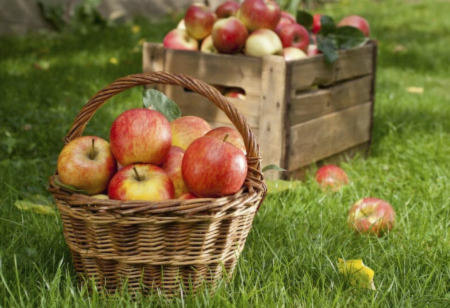
Climate Takes a Crunch Out of Indonesia's Apples


Indonesian apple producers rush to finish spraying pesticides onto their trees before yet another afternoon downpour as ominous clouds gather in the morning sky.
In East Java province, the dry season has begun; yet, nonstop rains have once again wreaked chaos for thousands of apple growers, disrupting the blossoming season, destroying blooms, and reducing harvests. Farmers in Pasuruan schedule the flowering and harvesting seasons in accordance with the weather, where the dry season typically begins in April and lasts until September.
to get the trees ready for the blossoming season, which lasts two months, they often start pruning trees in January. Harvesting starts in April.
In addition to increasing pests and diseases, the unseasonably warm weather has forced some growers to take out loans to keep up with the rising expense of pesticides to prevent years of labor from going to waste.
Farmers used to spray pesticides on their crops once a week in the past, but now they must do so twice weekly and use more powerful chemicals.
Depressing yields hardly meet farmers' production costs after years of highly erratic weather. The prolonged rainy season and rising temperatures, which represent a serious threat to Indonesian apple growing, a sector that historically provided solid incomes for thousands of rural communities, are attributed to climate change, according to specialists in agriculture.
Indonesia is not the native of the apple, however, it is observed that the fruit was first planted in the Pasuruan regency, where the village of Andonosari is located, around 1930 by Dutch colonizers. Besides that apple orchards are a major source of agro-tourism in these regions, with Indonesians visiting them in droves to collect the fruit and take advantage of the milder climate.
Nowadays, East Java province, which has a subtropical highland climate, is home to some of the greatest apple-growing regions in the 270 million-person nation. These regions include Batu, Malang, and Pasuruan. Manalagi, which means ‘where else’ in Indonesian, is one of the most well-known apple varieties from the area. It is green, tiny, and sweet and aromatic without being overly juicy. It is available in stores all around Java, including Jakarta, and is used to make apple crisps, juice, and jam, among other things.
However, the nation's apple production has been steadily declining.
According to official statistics, the fruit's output in Batu has decreased significantly from more than 142,000 tonnes in 2007 to 23,000 tonnes in 2020, causing a devastating blow to farmers whose families have depended on the crop for generations to survive. A stable cold and dry season, which is ideal for growing apples, used to last for several months for growers.
Unpredictable Weather
Yet due to the unpredictable weather, farmers say that it is scorching one day and rainy the next. As a result, to increase their incomes, many farmers now plant flowers in addition to other crops including oranges, carrots, tomatoes, and other vegetables.
Long periods of downpour and record high temperatures, according to climate change scientists, pose a major threat to apple growing.
The revival of apple orchards, advancement of farming methods, and expansion of climate-resistant apple cultivars have been gradual and insufficient.
According to experts, the government must help apple growers in the same way it has helped oil palm farmers, who may receive financial aid of up to 30 million rupiah per hectare for the renewal of oil palm trees as well as help obtaining superior seeds.
In efforts to improve the quality of their soil and control pests like aphids, pests and fungus, farmers have turned to powerful synthetic fertilizers. Some farmers have been compelled to obtain bank loans due to the exorbitant costs of these chemicals.
However, farmers and experts worry that Indonesia's orchards may eventually be destroyed by worsening global warming. Further increases in temperature, rainfall, humidity, and the frequency of extreme weather will worsen environmental harm if climate change is not rapidly and drastically reversed.
Also, experts fear that, starting in 2050, environmental impact will get worse. Since apple trees are climate-sensitive, the future is undoubtedly dangerous.
Switching to Planting Oranges
Many apple growers in the area have started growing other crops on the same piece of land or converting to planting oranges, which they claim are easier to maintain.
According to farmers who shifted to growing oranges, oranges don't require much care and only require the usage of pesticides every two weeks, as opposed to twice a week for apples. For every hectare of apple trees, production costs can reach roughly 100 million rupiah (S$9,500), and the majority of farmers must take out loans to pay for at least half of that. They are compelled to sell their cattle or any other belongings they have to pay their debts when the harvest is inadequate.
According to IndexBox Apple exports from Indonesia fell drastically in 2021 to X tons, a reduction of -17.8 percent from the previous year. Exports had a severe decline throughout the time period under consideration. When exports rose by 2,560 percent in 2015, the growth rate was at its fastest. The exports reached their peak in 2012 at X tons, but they continued to decline from 2013 through 2021. Apple exports in value terms fell sharply to $X in 2021. Exports overall were significantly reduced. The fastest rate of growth was seen in 2015, when exports rose by 3,492 percent.
The two-year falling trend in apple exports was finally reversed in 2021 when they increased to X tons for the first time since 2018. Imports generally showed a rather flat trend pattern. The year 2016 saw the highest growth rate, with imports rising by 66 percent. In the near future, imports are anticipated to expand gradually after reaching their high in 2021.

